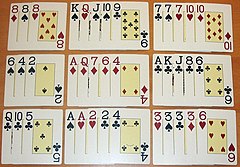Chinese poker

Standard Chinese poker hand
|
|
| Origin | China |
|---|---|
| Players | 2 - 4 |
| Cards | 52 |
| Deck | French |
| Play | Clockwise |
| Card rank (highest to lowest) | A K Q J 10 9 8 7 6 5 4 3 2 |
| Playing time | 2 - 5 min. per round |
| Random chance | High |
| Related games | |
|
Pai gow poker Open-face Chinese poker Poker |
|
Chinese poker also known as (Chinese: 十三张; literally: "Thirteen cards") is a card game based on poker hand rankings.
Chinese poker is typically played as a four-person game, though it can also be played with two or three.
In Chinese Poker, each player receives a 13-card hand from a standard 52-card deck. Each player then has to divide their cards into three poker hands (known as "setting"): two containing five cards each (known as "the middle" and "the back"), and one containing three cards ("the front"); the back must be the highest-ranking hand, and the front, the lowest-ranking hand (note that straights and flushes do not count in the three-card hand). The back hand is placed face down on the table in front of the player, then the middle hand is placed face down in front of the back hand, and the front hand is placed face down in front of the middle hand. After all the players have set their hands, each player will announce in turn (clockwise, starting from the left of the dealer) whether or not they are playing their hand. All players then announce their royalties, before revealing their hands.
If a player makes three flushes or three straights they automatically win the hand, regardless of the other players' hands. As shown in the photo, the middle player has made all three hands flush and is an automatic winner.
The stakes played for in Chinese poker are known as units: an amount of money agreed on before the game starts. Basic scoring rules dictate that a player collects one unit from each opponent whose front, middle or back hand is beaten by their own corresponding hand. Thus, unlike most poker games, being second-best at the table is good enough to win money. In some variants players are also paid an additional unit if they win in two or three of the hands. In other variants players only get an additional unit if they win all three hands (known as a scoop). Also, due to the head-to-head nature of the comparisons, it is possible for different players to play for different stakes. For example, A and B could play for $100 per unit versus each other, while all other player pairings play for $10 per unit. Many variations of scoring are in common use; refer to the external links for more information.
The two most common scoring systems used in Chinese poker are the 2-4 scoring method, and the 1-6 scoring method.
...
Wikipedia
